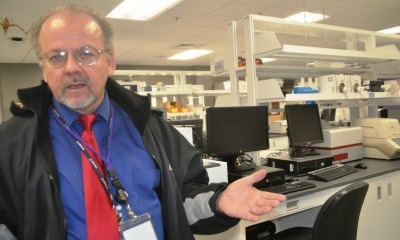April 12, 2016

Animal diseases pose significant threats to health and food security. Here are nine things to know about animal vaccine development according to three Kansas State University scientists involved in vaccine research.
1. Vaccine design is problem-solving
Developing a vaccine has many steps that range from finding the weaknesses in organisms to finding ways to deliver the vaccine and test its effectiveness. Because the knowledge required spans disciplines, collaboration is vital. "Vaccine design is problem-solving," said Raymond "Bob" Rowland, professor of diagnostic medicine and pathobiology in the university's College of Veterinary Medicine.

VACCINE RESEARCH: Raymond "Bob" Rowland, professor of diagnostic medicine and pathobiology in the university's College of Veterinary Medicine, is shown here in K-State's level 2 research lab. He is among the K-State researchers working on vaccines to fight animal diseases.
2. The challenge is finding the approach that works best
A vaccine's purpose is to stimulate the recipient's immune system so it produces antibodies to fight off disease. Every vaccine must contain an antigen, the substance that induces the immune response. The antigen can be a live attenuated — or weakened — virus; an inactivated virus; or a subunit, a protein that doesn't cause infection. "The challenge is finding what's efficacious," said Jishu Shi, professor of anatomy and physiology in the College of Veterinary Medicine.
3. Adjuvants make vaccine more effective
Adjuvants, another component of vaccines, are added to make the vaccine more effective by enhancing, accelerating or prolonging immune response to antigens. These are particularly important in vaccines that don't use a live attenuated virus as an antigen to ensure the desired immune response occurs. "Evaluating adjuvant takes time," Shi said. "After you formulate a good adjuvant, it takes two more years to do the studies."
4. Cost is key: Vaccines have to be affordable
Animal vaccines need to be inexpensive. "As soon as someone said Zika, Obama said $1.8 billion," Rowland said. Animal diseases don't tend to get that kind of response. "We have to take rational approaches that are doable and also fundable," he said. "Pig vaccines have to be 20 cents apiece so producers can afford them," he said.
5. Health of animals and humans interconnected to environment
Human vaccines must be tested to find out how they affect animals and the ecosystem. This is known as the One Health concept, which recognizes the interconnections between the health of animals, humans and the environment. A vaccine developed against the Zaire strain of Ebola is one example. The vaccine uses genetically engineered vesicular stomatitis virus, an animal disease, to express Ebola glycoproteins and provoke an immune response against Ebola. That means testing the vaccine to see how it affects animals is a crucial step in determining its overall safety profile. "We support public health when we study the safety profile in animals of a vaccine that will be used for humans, too," said Jürgen Richt, Regents distinguished professor of veterinary medicine and director of the U.S. Department of Homeland Security's Center of Excellence for Emerging and Zoonotic Animal Diseases in the College of Veterinary Medicine.
6. Being able to tell infected animals from vaccinated ones is essential.
Inactivated and subunit vaccines against animal diseases are good because they don't introduce a live virus into the environment and because they allow us in some cases to differentiate infected from vaccinated animals in the event of a disease outbreak. This is known as a DIVA vaccine. "Governments want DIVA compatibility," Richt said.
7. Challenge in marketing vaccines for diseases that exist only outside U.S.
The realities of producing DIVA vaccines are complicated, because some high-consequence animal diseases, such as Rift Valley fever, classical swine fever and African swine fever, exist only outside the U.S. "It's very easy to say, but much more difficult to do to move a product that doesn't have a market here in the U.S.," Richt said. "It costs money to do the efficacy tests and work on a dossier for the USDA. We need companies that see a market for their product in African, Asian and Arabian countries and are willing to sell it to the national stockpile in the U.S."
Rowland said the ultimate goal is to both help the world and "create Fortress America" by protecting it from animal diseases that are present outside our borders. Existing vaccines for Rift Valley fever, classical swine fever and African swine fever use attenuated live viruses. Introducing a live virus of any kind entails risk, and if the disease ever breaches our borders, we want to have safe, effective, and relatively inexpensive vaccines on hand to protect domestic livestock, he said.
8. Vaccine studies need containment facility like K-State's BRI
Vaccine studies often need to be conducted in containment, which requires specialized facilities and equipment to maintain safety of people, animals and the environment. Kansas State University researchers use the university's Biosecurity Research Institute for this. "We have the people, the facilities, and the capacity to do this kind of work," Richt said. "BRI is crucial to what I'm doing," Shi said. "It's an important part of our daily work and our success."
9. K-State Research projects are in various stages of development
Future goals include development of universal vaccines that protect against existing and emergent strains of diseases such as influenza and understanding the mechanisms of genetic resistance to disease so we can fight disease in new ways. "What's so cool about genetics is we say, 'We found a cure!' We start with a cure, then refine it backward," Rowland said.
Richt, Rowland and Shi share the goal of developing rationally designed vaccines that are safe and efficacious and preferentially offer DIVA compatibility. Their vaccine development and testing projects are in various stages, but all of them guard animal health and help keep food on our tables. Richt's team is developing Rift Valley fever and African swine fever vaccines.
Rowland is working with both classical swine fever and African swine fever, and is collaborating with researchers at the University of Missouri and a private company to develop pigs that are resistant to porcine reproductive and respiratory syndrome, or PRRS. Shi's ongoing projects include a DIVA classical swine fever vaccine and a universal PRRS vaccine. All three researchers manage labs staffed by scientists, doctoral students, postdoctoral researchers and students.
Source: Kansas State University News Service
You May Also Like




